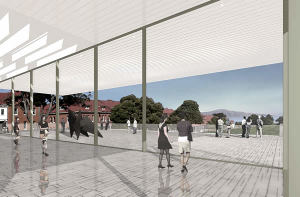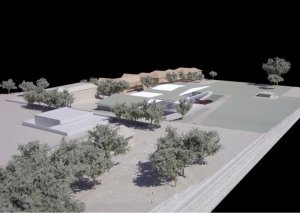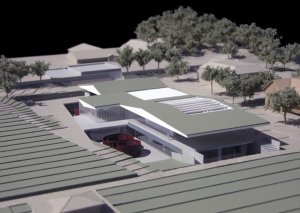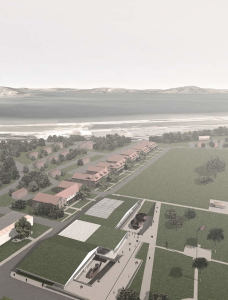More and more articles keep appearing about the new design for the Contemporary Art Museum at the Presidio (CAMP) in San Francisco, intended to house Gap founder Donald Fisher’s art collection. Yet most of them are not linking the underlying issues: hubris and the commonweal. Viz: the very wealthy feel entitled to do what they want where they want, but how does the citizenry acknowledge their generosity without being force-fed self-aggrandizement? Can the ego needs of the superrich be satisfied in line with the common good? And specifically, is the Presidio the right place for private or modern development?
Let’s start with hubris. After the public outcry over the first CAMP design by architects Gluckman/Mayner, there was the “CAMP: Reconsidered” exhibition and forum at Mark Horton’s 3A Gallery, in which ten local architecture firms each proposed alternate strategies for the museum design. Out of all that came at least one big idea: move underground. Judging from the new design, as released last week by the hometown team, WRNS Studio, the building is partially subterranean, which is very good news. But the above ground bit hasn’t moved off the historic parade ground (currently a parking lot), which was a surprise, and the design is timid, which isn’t a surprise given the blood sport of development in San Francisco.
The Presidio Historic Association was not pleased, and devoted its March newsletter to the issue (www.presidioassociation.org). The association is lumping the new museum in with other proposed developments at the Presidio and calling foul. Architect George Calys, in his design blog for the San Francisco Examiner, suggested that the Presidio Historic Association might file suit. While the museum would honor Don Fisher, it is not a for-profit entertainment center or hotel. But what is the hubbub really about?

From camptoday.org

From camptoday.org
It was difficult to determine what the design is from the four images released on CAMP’s website (www.camptoday.org). They seem intentionally vague. Even an informed viewer can’t figure out what the materials might be or how they would read. It was rumored that more images of the model were going to be posted on the website last week, but instead they are visible to dignitaries invited to the architect’s office. This week it was announced that there will be a public meeting at the local chapter of the AIA on April 1 (an odd choice). Trying to control the information flow too carefully may not be in the best interest of CAMP.
In Golden Gate Park, Renzo Piano lifted the park up into the air to create the new Academy of Sciences. At CAMP, the big move is to fold the green roof to reveal the contemporary treasures contained within. This is where the architects have been tentative and should consider a bolder stand. Emphasize the big move. Right now, viewed from the air, it will look like the parade ground continues. In the spirit of modernism, let’s call it what it is: pleats in the parade ground.
Perhaps the architects should consider collaborating with a conceptual artist like James Turrell, Michael Heizer, or Robert Irwin to celebrate the pleats. The gentle roof is a response to the public outcry over the initial design. The earlier solution may not have been the right one, but that doesn’t mean we don’t want something dramatic. A bold design and the opportunity to have a say might just mollify us design types. Nothing will mollify the folks who hate Fisher and/or the idea of a museum in the Presidio, so let’s do something memorable.
There seem to be two really fervent anti-CAMP camps, which of course overlap. One camp feels that the Presidio is threatened by the proposed development. Another camp hates Don Fisher. The editorial in a recent San Francisco Bay Guardian links them rather succinctly (www.sfbg.com), and says that automobiles will overrun the Presidio if CAMP is built there. I am no expert in traffic counts, but every time I go over to the Presidio, it’s almost empty. I love the post office and bank there because they have no lines! I think the place could handle a little more traffic, not to mention diversity. I have to agree with the Bay Guardian that there is a problem with asking the Presidio to be financially self-sufficient, a Reagan/Thatcher-era idea that won’t succeed. Let’s use this moment of respite from the folks who would privatize our national parks and undo that mess. While that issue is related, however, it is distinct from the CAMP proposal.

From camptoday.org

From camptoday.org
Let’s face it, the underlying issue here is really Don Fisher. He is a very successful Republican capitalist in a city that likes its rich folks to be Democrats and modest. It doesn’t help that he made his fortune on garments manufactured in Asian sweatshops or that he advocated for more parking in downtown San Francisco. Nor that his attitude has been that of an entitled white male Republican. He might take a page from a fellow zillionaire’s playbook and sponsor a music festival and look humble. But a rich guy in his 80s ain’t going to change his stripes. And if he passes away before this is settled, the collection could very well be broken up.
Let’s not forget the commonweal. My bet is that Fisher won’t compromise much more than he has and will take his collection somewhere else if this project doesn’t move forward. The anti-Fisher group may want that outcome, but the city and the region would lose an important art collection. If it belonged to somebody less controversial, we would be having a different kind of argument.
An art collection this good is a great gift. But unfortunately, this is where hubris comes in again. The art cognoscenti and some school kids (featured in a rather odd video that has been removed from CAMP’s website) have seen parts of the collection, but by and large, the public hasn’t. It is more than a little strange that there wasn’t a little more planning in this regard. Most wealthy philanthropists want to build some excitement around their donation, and to that end they mount exhibitions drawn from their collections. But as others have pointed out, Fisher seems to have adopted a take-it-or-leave-it attitude. In a strange twist, almost every mention of Don or Doris Fisher has been removed from the CAMP website.
A number of people have commented about the Board of Supervisors’ recent public endorsement of the museum idea. That endorsement might help should Fisher have to revert to a back-up position, like returning downtown and/or to SFMOMA. The problem here is that most of the available sites in town are in Supervisor Chris Daly’s district. (He voted against the motion.) It’s a little hard to imagine Don Fisher and Chris Daly negotiating about a cup of coffee, much less a museum. However, at the end of the day, if things get stickier out at the Presidio, Fisher may have to align with SFMOMA. The museum might be willing to compromise on Fisher’s level of involvement if it looked like he was otherwise going to let the collection be dispersed. (Check out his interview with San Francisco Chronicle art critic Kenneth Baker at www.sfgate.com or on CAMP’s website.) You see, Fisher (or his heirs) could just sell the whole damn thing, as Pierre Bergé did with Yves Saint Laurent’s collection, and use the funds to start a new country.
From a strict urban design point of view, it probably is better to keep museums in the museum district. But the Presidio’s collection of bland landmarks could be improved by a dramatic piece of modernist architecture. It is narrow minded to think that we can only have historic or historicist buildings in the Presidio. And to speak of the military base as “sacred ground” is just bizarre. Sometimes a well-crafted contemporary intervention makes us see something historic more clearly, like Piano’s new Morgan Library addition in New York, or Scarpa’s additions to the Castelvecchio Museum in Verona. Remember that the Pompidou renewed the Marais and made it visible in a new way. If anything, the Presidio will be ruined by more faux historic buildings that make the place feel like Disneyland. This round, let’s hope for an engaged public process, especially with the design community, and let the architects keep designing something bolder for the 21st century and beyond. As much as I don’t want to admit it, punishing Don Fisher for being a rich capitalist by nixing his museum in the Presidio, or making its design too vanilla, probably isn’t in the region’s best long-term interests. But pushing for an artistic expression to house his collection in the Presidio is.

